Bond Bibles - Steven Jay Rubin
2nd November 2021
Meet Steven Jay Rubin, the historian behind the first comprehensive Bond movie history
Ever since Ian Fleming wrote Casino Royale many authors and journalists have explored and celebrated the James Bond phenomenon. While some books have been official, large format publications, others have delved deeper into specific areas of the subject. In this new series Matthew Field will meet both high-profile writers as well as some of the world’s most knowledgeable “007” experts, who have contributed to the James Bond bibliography.
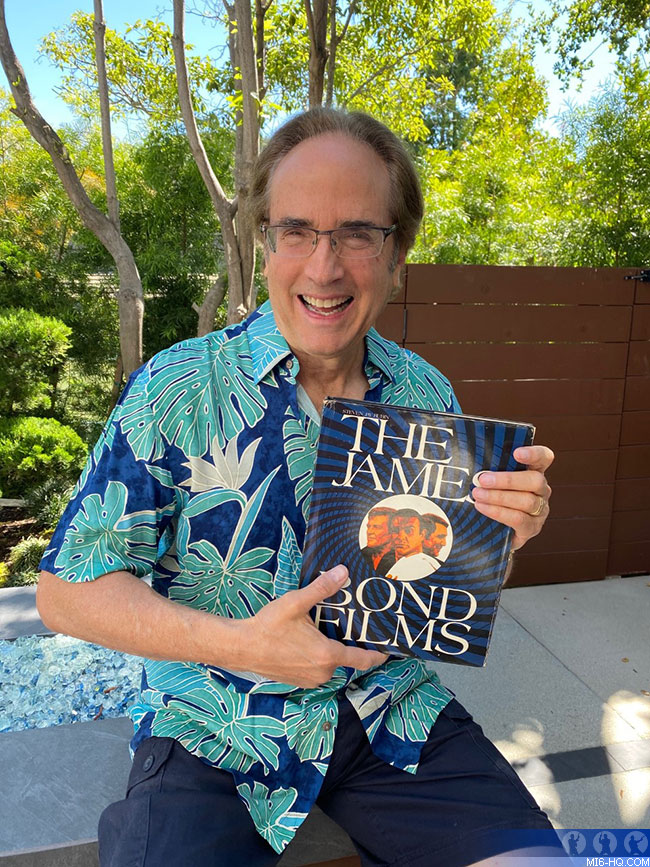
Steven Jay Rubin
– 09 September 1951
Bond Bibles:
- The James Bond Films: A Behind the Scenes History (Talisman Books, Arlington House, Crown Publishers, 1981, 1983)
- The Complete James Bond Movie Encyclopedia (Contemporary Books 1990, 1995, McGraw Hill 2003)
- The James Bond Movie Encyclopedia (Chicago Review Press, 2020)
Left: Steven Jay Rubin (From the Steven Jay Rubin Collection, all rights reserved.)
Steven Jay Rubin is the author of 'The James Bond Films: A Behind The Scenes History, The Complete James Bond Movie Encyclopedia', and most recently, the completely revised 'The James Bond Movie Encyclopedia'. For more than four decades Rubin has enjoyed a successful career in Hollywood as a film historian, author, screenwriter, documentarian and publicist. He has also produced his own films, including the World War II drama, ‘Silent Night’ (2002) starring Linda Hamilton. In 1992 Rubin was involved in the early special edition Criterion LaserDiscs of the first three Bond movies. More recently he produced the special features to accompany the Blu-ray release of both ‘Casino Royale’ (1967) and ‘Never Say Never Again’.
The James Bond Films was published in 1981 and was a landmark book in that it was the first to delve into the making of the 007 series and the talented team who brought the movies to the screen. Forty years on, Rubin reflects on his fascinating journey researching what is still regarded as a key Bond text.
Matthew Field's Bond Bibles
As a kid I had heard about The James Bond Films: A Behind The Scenes History and always hoped to find a copy. This was the pre-Internet age. In the summer of 1994, I finally found it in a second-hand bookstore in Portland, Oregon. I was spent out but my brother lent me his last five bucks to buy it. I immediately read it from cover to cover and digested every last paragraph!
Over the years…and it's been more than 40, I have received wonderful notes from Bond fans all over the world, telling me how much the book meant to them. It's tremendously rewarding when fans reach out to authors as we write alone and for the most part we research alone. We're working in that tall, tall tower, trying to put together the best book we can. Those shout-outs mean a great deal.
When did you first discover the world of James Bond 007?
Well, let me tell you how I became a film buff first. I was born in Chicago but I grew up in Los Angeles – moved there when I was four years old. We lived across the street from a movie theatre. I was there every Saturday morning for their two science fiction features and I would go to the movies with my parents at night. So I was probably seeing 3-4 films a week. My mother loved movies and through her I was learning the names of actors and film titles practically before I learnt my ABCs.
Is this where you saw your first Bond picture?
Actually no. I discovered Bond via the novels. My father would go away on business trips and he was always reading. He would come home with a suitcase full of paperbacks. In early 1964 he brought home a copy of 'Goldfinger' and dropped it on my desk. I was 12 years old at the time and a very sheltered only child, so this book, with a naked woman on the cover got my hormones racing. Before long I remember everyone at school was reading Fleming. Those bright, colourful American Signet paperbacks were everywhere. And then the film 'Goldfinger' opened in the States later that year. It was a seminal moment for me because I saw it that Christmas at Grauman's Chinese Theatre in Hollywood and to see a movie there was a big deal! And before long 'Dr. No' and 'From Russia With Love' were back in US theatres on a double-bill. I was hooked!
How did you turn your passion for film into a profession?
I studied History and Journalism at UCLA. I was trained as a journalist, a historian, a researcher. I began writing for The Daily Bruin, UCLA’s student newspaper. I enjoyed research and I enjoyed talking to people. When I left UCLA I decided to write a book. I was obsessed with World War II, as most kids were, growing up in the late 1950s. So my first book was 'Combat Films: American Realism 1945-1970'. I interviewed over 50 filmmakers. It was published and sold about 500 copies. It was very niche and I wanted to get a bigger audience.
Is that when you came up with the idea of writing a behind the scenes history of the James Bond films?
Yes. I had read John Brosnan’s 'James Bond in the Cinema', which was the first book published on the Bond films. John’s book was more of a tribute, more of a celebration, not a researched history. By the mid 1970s I was writing for Cinefantastique magazine, a Chicago film journal, and some of my in-depth retrospectives on films such as ‘Forbidden Planet’ (1956), ‘The Day The Earth Stood Still’ (1951) and ‘War of the Worlds’ (1953) were getting attention. I got a wonderful letter from the great film historian, Leonard Maltin, thanking me for my research.
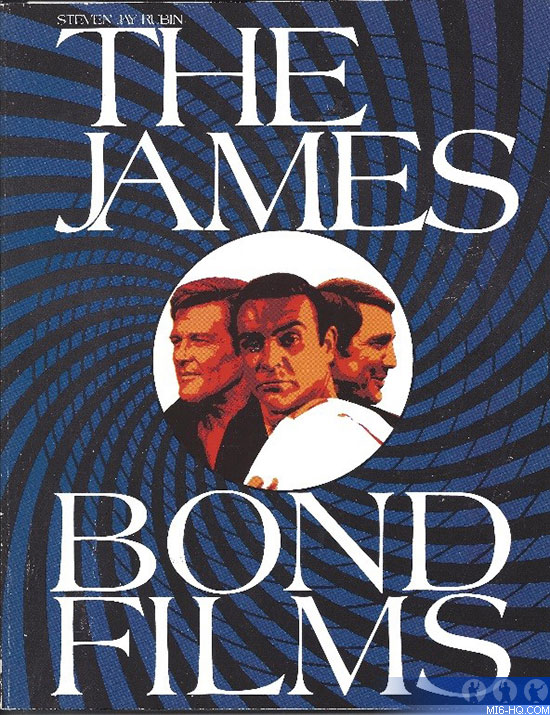
First Edition cover art for the 'James Bond Films' by Steven Jay Rubin.
How did your Bond project begin?
I came at the Bonds as a historian. I didn’t want to rely on second hand sources. I really wanted to speak to the actual filmmakers who made the movies. So I contacted Cubby Broccoli to see if I could get an interview. I wrote him two letters while he was on location for 'The Spy Who Loved Me' and his secretary informed me that I would have to wait until Mr. Broccoli was back in the States for an audience. Finally I was invited to meet Cubby at his office in the Thalberg building on the MGM (now Sony) lot. Everything was very formal when you went to meet Albert R. Broccoli! His office was the size of a small basketball court. He respected me as an historian and realised I was not some fly-by-night journalist looking to do something quick. I had a really nice interview. I was in the presence of a legend.
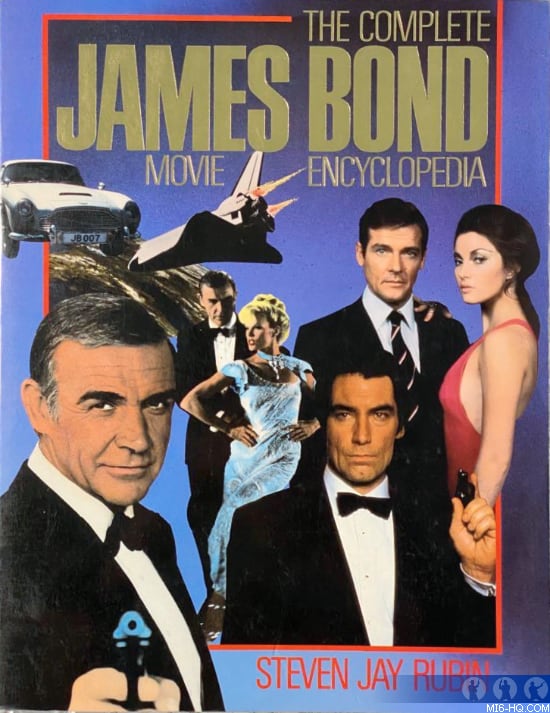
Above: First edition cover art of 'The encyclopedia'.
I understand you travelled to England on a research trip…
Yes and Cubby offered to introduce me to Michael Wilson who was living in London and working out of EON’s office on South Audley Street. Michael was a really fun person to be around and he showed me around London. I remember him telling me about buying beer for all the soldiers during the Fort Knox shoot on 'Goldfinger'. He was thrilled I was doing a historical look at the Bonds and he opened up all the filing cabinets for me. I was particularly interested in the call sheets and a lot of information I quote in 'The James Bond Films' comes from those call sheets. I wanted to know specifics.
During this period, Michael Wilson had only relatively recently taken up an official position on the Bond movies…
Yes, and he was very enthusiastic. Michael invited me to the first screening of ‘The Spy Who Loved Me’. I remember Michael and I driving out to Pinewood with Ken Adam behind the wheel of his Rolls Royce. I felt like I was the King of England! I remember Ken and Michael showing me how to wave, the Royal wave [Laughs]. There were all sorts of interesting people at that screening including Bob Fenn, Ian Fleming’s agent from MCA and Cubby’s lawyer Norman Tyre. There was a real party atmosphere and by the time Carly Simon’s song came on, well, it was just thrilling.
Tell me about some of the legendary figures from the early Bond movies you interviewed during that trip.
I visited Roald Dahl and his wife, the actress Patricia Neal, in Great Missenden, just outside of London. I remember sitting in their kitchen as Patricia prepared lunch for us. Roald was very elegant, very nice. He just spilled it all out and spoke about how he was the new boy on the Bonds when he worked on 'You Only Live Twice' Another great interview took place at Pinewood Studios with Terence Young. Terence was this mythic figure to me. He was a great raconteur. His stories were wonderful. I was fascinated to learn that director John Ford had been a mentor to him. I met Bernard Lee in a London pub and I remember him being very nice but a bit tipsy. He told me his show business debut was being carried on stage in a London theatre as a baby!
Director Lewis Gilbert had just completed ‘The Spy Who Loved Me’ and was about to embark on ‘Moonraker’ when you interviewed him…
Right. He was very nice but not at all flamboyant like Terence. I got a lot of information from Lewis about the writing process of ‘Spy’, all those drafts and writers that worked on that film.
That’s interesting because when Ajay and I were writing Some Kind of Hero, we felt the most in-depth source on the script development and story of ‘Spy’ was in your book.
Thank you. I spent a lot of time on that because I had access to all those scripts when I was researching at South Audley Street. I guess because it was the most recent film a lot of those drafts were easily accessible.
In those days did you record all your interviews?
These were the days when we were using early audiocassette recorders. I had a big bag of cassettes and I had this paranoid feeling that if I put them in my suitcase and it ran through the airport X-ray machine they would erase them. So I bought a special bag made of lead shielding to put my cassettes in!
You also secured some great interviews back in Los Angeles. I believe you are the only Bond scholar to have spoken at length with Harry Saltzman…
I met Saltzman at the Beverly Wilshire Hotel. I remember him being very sedate. It was a very strange interview because this was not long after his exit from his partnership with Broccoli in 1975 and he was forbidden to talk about Bond. So for two hours he sat and told me about his vaudeville career. Here I am in the presence of one of the key figures in the Bond story and he couldn’t tell me a thing! I actually learnt more about Harry Saltzman from Tom Mankiewicz than I did from Harry himself. I also visited Richard Maibaum at his home in Pacific Palisades a few times. Later on, I actually gave Maibaum the manuscript and he gave me some very helpful notes. And his son, Paul, who is a cinematographer, recently supplied me with some photos for my latest book.
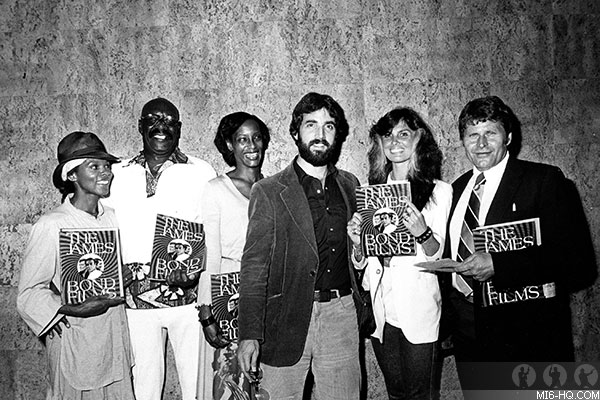
RUBIN WITH hiS BOnd 'BiBLe' AND An ARRAY oF Bond Cast Members, BRUCE GLOVER, CAROLINE MUNRO, TRINA PARKS, Julius Harris and Gloria Henry. (From the Steven Jay Rubin Collection, all rights reserved.)
Around the time you were writing The James Bond Films, Kevin McClory was hard at work trying to get a remake of ‘Thunderball’ off the ground. Did you approach him for an interview?
Yes. I went to Nassau for a week over the holidays of 1978/79. I visited him at his very sumptuous beachfront mansion and spent time with him and his brother Desmond. I do remember coming up the driveway and the A-bomb sled from ‘Thunderball’ was just lying by a bush gathering rust. We watched ‘Thunderball’ together and he pointed out his little cameo as Bond walks into the casino. Later I interviewed him for a second time at the Beverly Hills Hotel and there was a knock on his hotel room door and Claudine Auger walked in! I couldn’t believe it. Kevin gave me copies of both the Maibaum and Jack Whittingham’s drafts.
After that initial encouragement from Cubby did he ever ask to see the manuscript?
Well this is where I made a critical error. I transcribed the Terence Young, Peter Hunt and Richard Maibaum interviews and went in to Cubby’s office and gave him copies. That was a terrific mistake on my part. I should never have done that. I was talking to everybody from stuntmen to assistant directors to special effects people, to writers, directors and editors. As an historian, I wanted to be as complete as possible. Terence Young liked to embellish a little bit and I think when Cubby read Terence’s interview it rubbed him up the wrong way. I think Cubby thought, “I just don’t have the time to correct what they are saying.” Also, I actually got the chance to work with Kevin McClory. Kevin knew I had spent the previous year doing all this research so he hired me to read all the Fleming books and provide notes on specifics. I think that got back to Cubby and Michael. After giving me fabulous cooperation, Cubby just walked away from it. And then something terrible happened. Fred Clark, my editor at Cinefantastique, heard I was no longer getting official cooperation and unbeknownst to me, took out an ad in his magazine: a picture of Cubby in the centre of a telescopic site with the tag, “Why does this producer want this book stopped?" Because of Fred Clark my relationship with Eon was ruined. I really regret this happened because I really treasured my opportunity to meet Cubby and Michael.
How did you continue with the project Steve?
Well by that stage I had completed the manuscript but the battle was how do I illustrate it? I had now also lost United Artists’ cooperation with stills. I had 190 photos and when I took away all the official UA material, I had three left! I decided to conduct a worldwide search for photos of the Bond world that were not controlled by UA and I was very fortunate. For instance, I discovered that Life magazine had been on the set of ‘Goldfinger’ and they owned their photos so I bought some.
How easily did you find a publisher interested in publishing a book on James Bond?
I started to circulate the book proposal to a number of companies. But I was not getting a positive response. Then in the summer of 1980, I went to the American Booksellers Association Convention (ABA) in Chicago and met Kevin Gough-Yates, a British publisher. He had a company called Talisman Books. Kevin was very enthusiastic and understood my dilemma on the photos. He knew the book was un-publishable without them. He was very patient. Arlington House in America published the US edition.
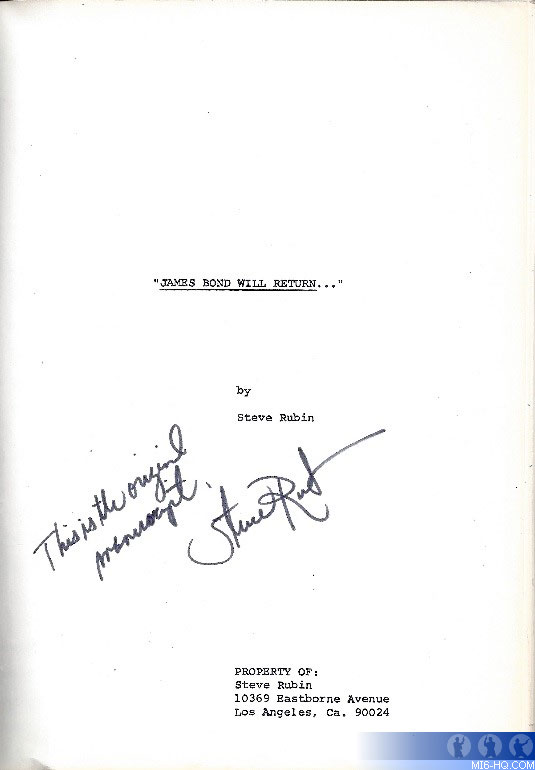
The original title for the book was 'And Now For My Next Miracle: The History of the James Bond Movies'. I think we also thought 'James Bond Will Return' could work. But Talisman went with 'The James Bond Films: A Behind the Scenes History', which was simple and elegant. I had no control over the cover design, although I did remark, “Could my name possibly be any smaller?” [Laughs].
Left: Signed first page of original typescript of 'The James Bond Films' showing Rubin's original title suggestion. IMAGE CREDIT: MICHAEL L. VANBLARICUM.
But you do have a great author’s photo on the back!
Oh sure, posing with Jane Seymour! I had pitched to the Los Angeles Times a tie-in article, ‘Where have all the Bond Girls Gone?’ The editor of the Times liked the idea. I called Jane’s publicist to see if I could get an interview. Not only did I get the interview, they asked if I would like Jane to take part in a photo shoot. My friend Bill Malone brought his Hasselblad camera and I was driving a Datsun 280Z sports car at the time, which, was subbed in as the Bond car. Jane was great, what a thrill! I got more comments on that photo than anything.
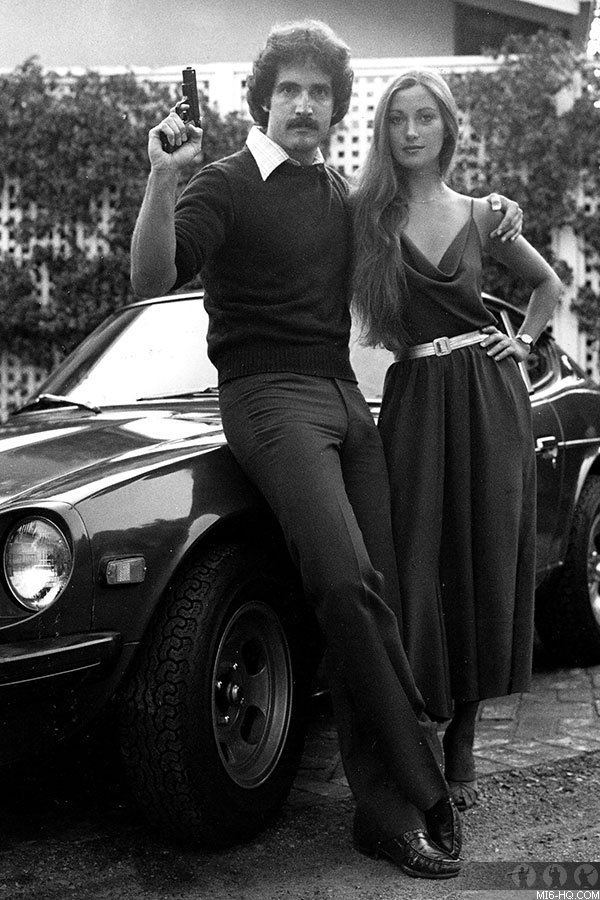
Author Steven Jay Rubin With Jane Seymour, as seen on the cover of 'The James Bond FIlms'. (From the Steven Jay Rubin Collection, all rights reserved.)
When we were writing Some Kind of Hero, Ajay and I often spoke about how fun your chapter titles were: ‘Mr Connery, the Doctor Will See You Now’, ‘Diamonds Are Forever but Connery is Not,’ ‘Beware Crocodiles Crossing,’ and ‘Dracula Meets Bond on an Island In the Sun’…
Matthew, I am sorry to say I virtually had no involvement in those titles. That was Kevin Gough-Yates and his editorial team.
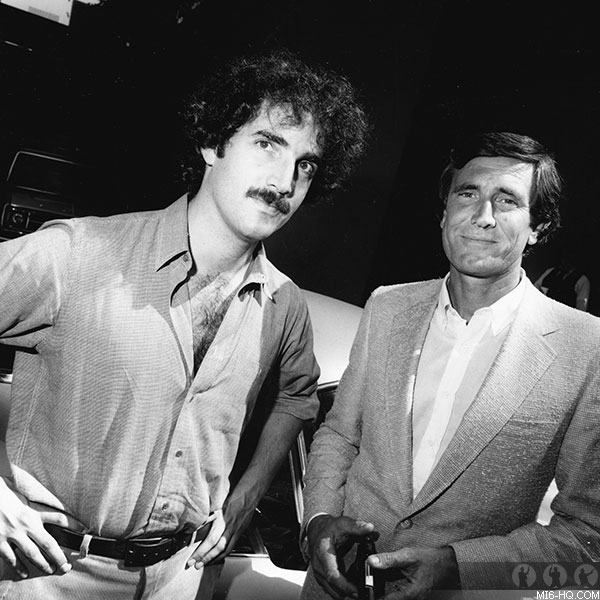
RUBIN WITH George Lazenby at the launch of 'The James Bond Films' (From the Steven Jay Rubin Collection, all rights reserved.)
Did you have a launch event for the book?
Yes, we held a James Bond weekend in Los Angeles. We took a full page out in Variety to announce the event, which included, a luncheon for a 190 people at the Playboy Club. Many Bond celebrities came along including George Lazenby, Barry Nelson, Hervé Villechaize, Norman Burton, Lana Wood, Rick Sylvester, Marc Lawrence, Bruce Glover and Martine Beswicke. We had an absolute ball. On the Sunday everybody came over to my apartment and we screened 'On Her Majesty's Secret Service' outside by the pool on a large screen with a projector. Holy-moly it was 40 years ago!
We know that movie books have a niche audience. But back in 1981, before the era of special edition DVDs and Blu-rays, as well as being the first behind the scenes book on the Bond movies, it must have sold very well?
It was very successful. A second, updated edition, which included 'Octopussy' and ‘Never Say Never Again’, was published in 1983. The two editions sold about 50,000 copies, which, was a pretty cool number. As you said, it’s a lot tougher now, because people are not buying books like they used to.
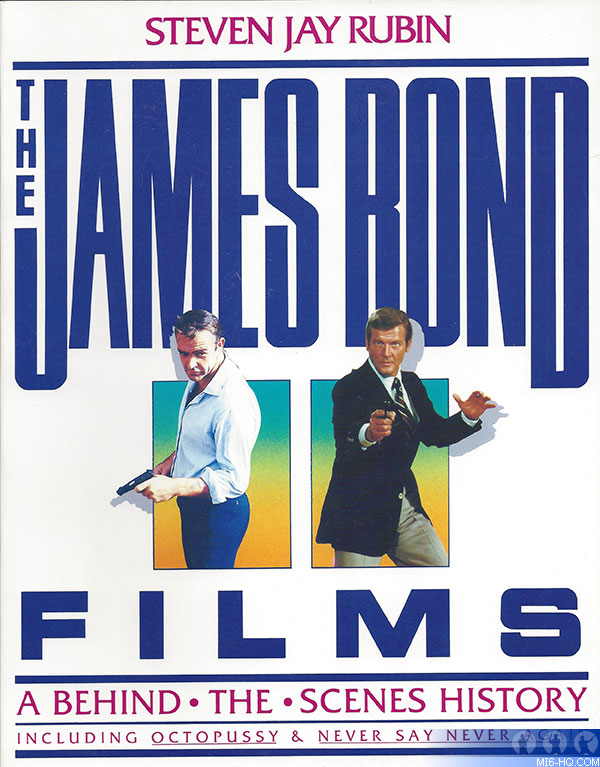
Revised Edition cover art for the 'James Bond Films' by Steven Jay Rubin, now including 'Octopussy' and 'Never Say Never Again'.
After such a great success why did you not continue to regularly update the book? After all, throughout the 1980s there was a new Bond movie every two years…
I was moving on and focusing on my own career in film publicity. I didn’t have time. And my fandom had kind of peaked. It wasn’t until Daniel Craig that I really got interested in James Bond again.
There was a German edition of the book, which had significantly more photographs, many of them in colour…
I was approached by Kino Verlag, a German book publisher. I was galled when this German edition came out with a cigarette advertisement on the back cover! They updated the book several times into the Pierce Brosnan era but I didn’t write any of that material.
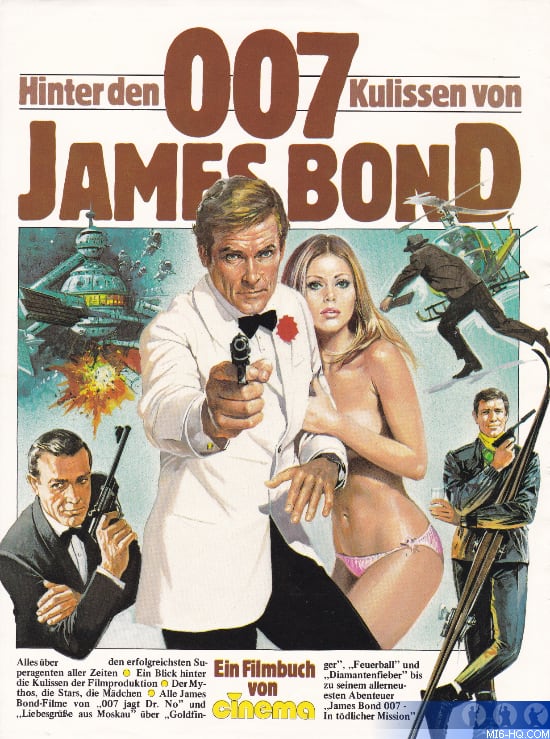
German edition of 'The James Bond Films'.
As you mentioned, you forged your own career in Hollywood as a unit publicist. Did this line of work lead you to work with any Bond alumni?
Actually yes. My first job was working for United Artists, the studio who releases the Bond movies. I was hired to go on the road all over the United States to promote the remake of ‘Invasion of the Body Snatchers’ (1978) at conventions. In 1986 I was hired by Jack Schwartzman, the producer of ‘Never Say Never Again,’ to work on both ‘Rad’ a BMX bike race movie and ‘Hyper Sapien: People from Another Star,’ which was directed by Peter Hunt. And then I worked for Showtime on a TV movie called ‘Taking the Heat’ (1993), which was directed by Tom Mankiewicz.
By 1990 you were enjoying a very successful career. What was your inspiration then to re-visit 007 with The Complete James Bond Movie Encyclopedia?
Contemporary Books of Chicago, had enjoyed success with Elvis Presley and Marilyn Monroe encyclopedias. And they reached out to me and asked if I could do a James Bond encyclopedia. I jumped at the chance because I had a lot of information, details which had just not fitted into 'The James Bond Films'. I liked the idea of the A-Z format and turning James Bond into a treasure trove of facts. Writing an encyclopedia is a lot of fun!
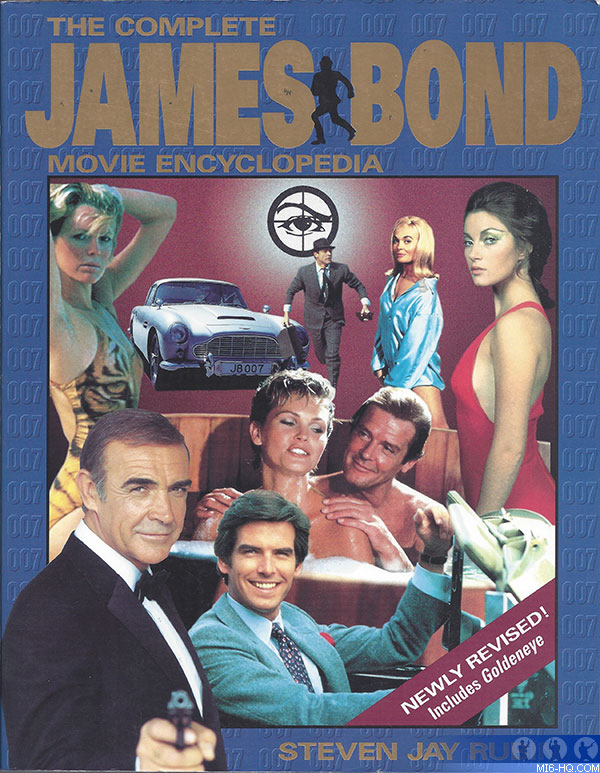
Revised Edition of Steven Jay Rubin's The James Bond Encyclopedia.
You secured new interviews as well. Reading the acknowledgements I noted you spoke with people such as Cec Linder who played Felix Leiter in Goldfinger…
Yes, this all happened in 1989. I also had a wonderful telephone interview with Maurice Binder. With all my interviews I always start out by asking as much about their backgrounds before I even ask them a Bond question. With Maurice Binder in particular, we didn’t know much about him other than he did the title sequences. I wanted to know more about him as a person. I was able to use a lot more of that biographical information in the Encyclopedia. I also went back to London (just as the Berlin Wall was coming down) to do more picture research. Somebody who was very helpful was Ronnie Udell, the former head of construction at Pinewood Studios. I went out to his house and he opened a trunk and he had oodles of behind the scenes pictures of the sets such as Fort Knox on ‘Goldfinger’ and the volcano from ‘You Only Live Twice.’
From the photos you have shared with me Steve, it seems you had another great group of Bond alumni attend your launch for the Encyclopedia…
We had a number of launch events. One was at a monthly science fiction convention held in Los Angeles at the Shrine Auditorium. I was able to invite a number of Bond veterans to appear on stage with me in a Q&A.
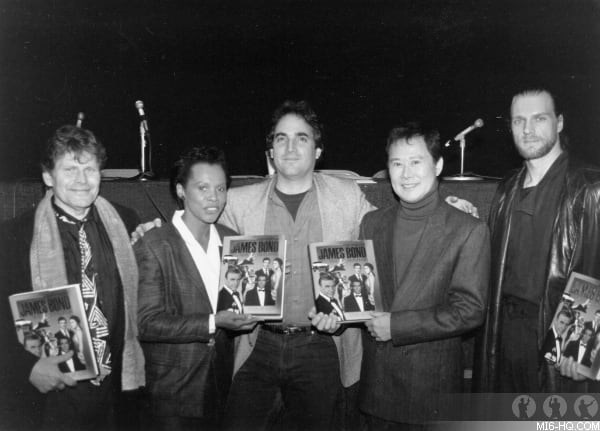
Book launch for 'The complete james bond movie encyclopedia' featuring Bruce Glover, Gloria Hendry, Soon-Tek Oh and Andreas Wisniewski. (From the Steven Jay Rubin Collection, all rights reserved.)
A second edition of the Encyclopedia was released in 1995 around the release of ‘GoldenEye’ and a third in 2003. And now 18 years later, an all-new edition re-titled The James Bond Movie Encyclopedia has been published. In what ways is this latest edition different, Steve?
Nearly every entry in the book has been re-written and features new information. It’s also the first of my books to feature colour. I had access to three or four great archives, Anders Frejdh at From Sweden With Love, Luc Le Clec from Club James Bond France and Michael VanBlaricum from The Ian Fleming Foundation. Also, a wonderful artist, Jeff Marshall, a name many fans will know, has provided artwork. I felt it was time to get back into Bond, especially since the Daniel Craig films had reinvigorated my interest.
Your new book is a great addition to the Bond library, Steve. However, you will always be remembered for The James Bond Films because it was the first book to delve into the making of the franchise…
That book meant a lot to me because it wasn't a slam-dunk to get it published. I am very proud that I was one of the first to detail the behind the scenes history of the James Bond films. I had enormous issues with acquiring the appropriate photos, and there was a sense of apprehension that my publisher would drop the book altogether but it all came together and the response to the finished product was overwhelmingly positive. I hope to autograph your copy some day!

Current edition of the 'James Bond Movie Encyclopedia' by Steven Jay Rubin.
Special thanks to Michael L. VanBlaricum.
Get Bond in Your Inbox
Sign up for occasional email updates from MI6. Get notified of breaking Bond news, and digests of recently releases features:












